The ultimate fashion sector guide

The rapid growth of the fashion industry and its ever-changing trends can put enormous pressure on supply chains. In this guide, we're threading a needle through the complexities of fashion logistics to help your business strut along the catwalk to success.
First, let’s take a look at the industry as a whole. Business is booming; fashion is the largest e-commerce market in the world1, and is forecast to hit a valuation of US$1 trillion in 20242. Globally, it’s estimated that the industry produces a staggering 100 billion items of clothing per year3 – double that of twenty years ago.
China, unsurprisingly, is the world’s biggest exporter of clothes4 – both in terms of B2C and B2B – driven by demand in the US, the EU, Japan and the UK. The country’s long-standing manufacturing capabilities make it unrivalled in its ability to supply volume products from designers’ catwalks in record time – and for minimal cost.
Amidst this volume, sustainable brands are also growing in popularity; those exploring alternative, greener manufacturing and logistics processes.
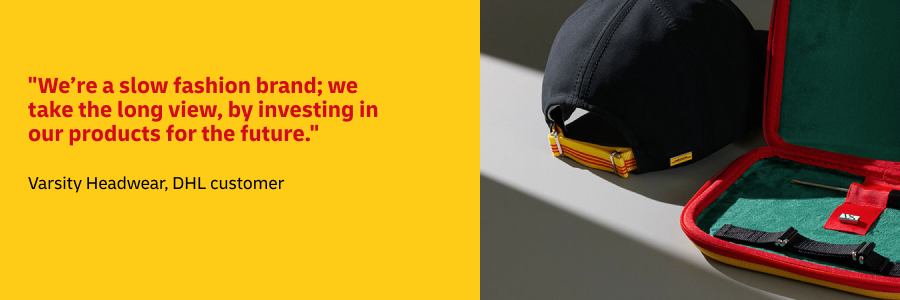 One such brand is DHL customer, Varsity Headwear. Based in Norway, Europe, the fashion brand wanted to maintain a commitment to ethical practices, even as it expanded globally.
One such brand is DHL customer, Varsity Headwear. Based in Norway, Europe, the fashion brand wanted to maintain a commitment to ethical practices, even as it expanded globally.
“We saw a substantial part of our emissions came from logistics and transportation,” says co-founder Sebastian Adams. “We wanted to face this issue, not hide from it, so jumped on the opportunity to work with DHL to learn from each other and improve. We’re carbon neutral through offsetting, and are now working towards insetting, too.”
With sustainable fashion in the spotlight, rental platforms and second-hand marketplaces are thriving – resale platform Vinted’s astronomical growth over the past few years is testament of Millennial and Gen Z shoppers’ embracement of “conscious consumption.” The economy is also having an influence – McKinsey’s annual deep dive into the sector, The State of Fashion 20235, noted that consumers’ financial circumstances will lead them to “seek out bargains, increasing the demand for resale, rental, and off-price [sale] products.”
The luxury sector is leaning into the sustainability trend, too. In 2021, Louis Vuitton and Cartier launched Aura – the world’s first global luxury blockchain – where consumers can track the entire lifecycle of a product by scanning its label.
And there’s a curious twist – despite volatile global economies and record-high inflation, McKinsey6 forecasts the luxury sector will grow between 5-10% this year, as consumers consider an investment in high-quality goods to be a sustainable decision in the long-term.
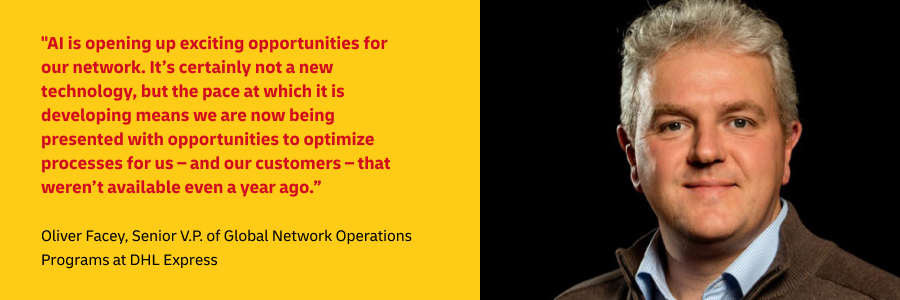 Whilst sustainability is a growing consideration to consumers, their high expectations of the luxury sector remains. New advances in AI technology are enabling brands to deliver more immersive, personalized and memorable experiences.
Whilst sustainability is a growing consideration to consumers, their high expectations of the luxury sector remains. New advances in AI technology are enabling brands to deliver more immersive, personalized and memorable experiences.
Gucci, for example, uses AI to amplify its brand storytelling, moving online advisors away from traditional customer service response templates, and reducing the time it takes to onboard new team members on the brand’s voice, history and products. Meanwhile, Valentino has introduced virtual try-on technology for its ready-to-wear collections, so customers can visualize how a garment will look on them through their smartphones prior to making a purchase.
AI is also playing a vital role in enhancing brands’ logistics processes, such as optimizing delivery routes to get orders to customers quicker, and anticipating consumer demand to maintain optimal inventory levels.
As consumers’ demands continue to rise, and the rapid rate at which the fashion sector moves showing no signs of slowing, brands will need to lean into AI – for both their customer experiences and logistics – if they’re to keep up. As we move into 2024, expect brands to continue investing in technology innovations, steering the sector into an exciting new era.
So we know the fashion industry is booming, but how can you make changes to ensure your business is efficient in 2024? Below we share some useful insights and tips to help.
FASHION LOGISTICS
Insights & best practices to help your business own the runway.
 The global second-hand apparel market is set to double by 2027, and is growing 3X faster than the apparel market overall. As consumers become more sustainably minded, brands with a considered approach to the lifecycle of their clothes will be favored.
The global second-hand apparel market is set to double by 2027, and is growing 3X faster than the apparel market overall. As consumers become more sustainably minded, brands with a considered approach to the lifecycle of their clothes will be favored.
How your business can "go green"
- Integrate a reverse logistics strategy – this promotes the extending of products’ lifecycle via the “4 Rs”: recycling, repurposing, repairing and reselling. This model can save your business money, reduce wastage, boost its sustainability credentials, and build loyalty amongst customers.
- Utilize DHL’s GoGreen Plus, a dedicated solution which is helping e-commerce businesses reduce the carbon emissions associated with their shipments through the use of Sustainable Aviation Fuel. This biofuel is specifically designed to be used as a substitute for traditional jet fuel and can reduce greenhouse gas emissions by up to 80% compared to fossil fuels.
- Consider Resale as a Service (RaaS). This model connects businesses with external recommerce solutions to create bespoke resale channels, giving garments an extra lease of life – and your business an additional revenue stream.
- Take inspiration from fashion retailers Garment Collecting program, which invites customers to drop off unwanted clothes – from any brand – to one of the stores. From there, they are either resold as second-hand or shredded into textile fibers to make other goods.
- Reduce your returns rate. Every product return means extra transportation emissions, which increases your business’s carbon footprint. Of course, the cleaning and processing of products ready for resale will cost your business money, too. A good place to start is to look closely at the leading reasons why your customers are returning products. For example, online shoppers typically order several sizes of clothing to try on at home – this is where investing in virtual try-on technology could be beneficial to your business, allowing customers to visualize how a garment will look on them before buying.
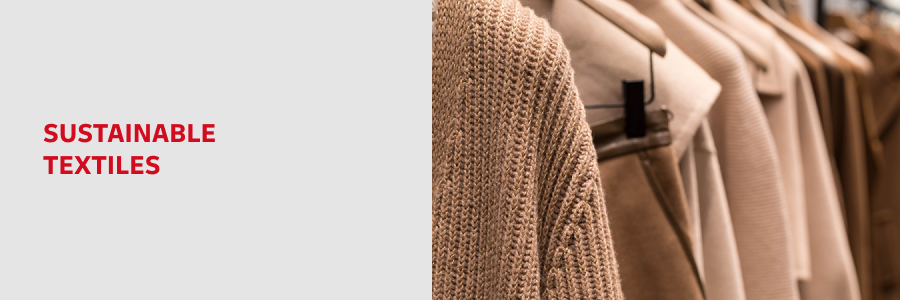 The textile sector is responsible for 6% of global greenhouse-gas emissions, whilst the dyes used in manufacturing cause one-fifth of industrial water pollution7.
The textile sector is responsible for 6% of global greenhouse-gas emissions, whilst the dyes used in manufacturing cause one-fifth of industrial water pollution7. What your business can do
- Prioritize sustainable materials for your garments, like organic cotton or recycled fabrics, and those grown without pesticides or chemicals.
- Take inspiration from apparel brands like Pangaia – its collections are made from plant-based denim and grape leather, whilst its natural dyes are created from vegetable waste.
- Research your supplier’s environmental policy, and whether it has been certified by an industry body.
- Enlist an independent audit of your textile supply chain. Some experts, for example, provide a rating for textile companies to demonstrate their achievement on sustainable development.
 Consumers’ purchasing journeys often involves several channels, so brands will need to invest in an omnichannel strategy to ensure a seamless experience across all touchpoints.
Consumers’ purchasing journeys often involves several channels, so brands will need to invest in an omnichannel strategy to ensure a seamless experience across all touchpoints.
Tips for your omnichannel strategy
- Consider investing in a dedicated mobile app for your business. Customers browsing your products in store will be able to quickly access extra product information, or even arrange for their in-store purchase to be delivered to their home.
- Brands without a bricks-and-mortar presence should test technologies like livestreaming and augmented reality try-on experiences to give customers a better sense of the product.
- Consumers use social media for product inspiration and discovery, but it’s important to be aware of changes providers can implement. Always keep an eye on all your platforms for updates.
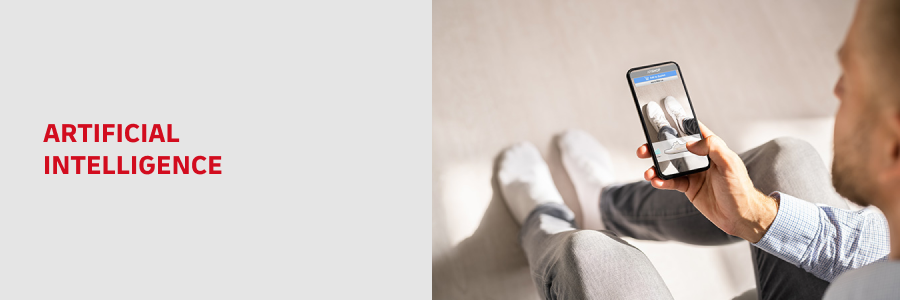 Artificial Intelligence is transforming almost every industry, and fashion is no exception, where the technology is enabling the new and innovative experiences that the sector demands. Here’s a snapshot of its applications:
Artificial Intelligence is transforming almost every industry, and fashion is no exception, where the technology is enabling the new and innovative experiences that the sector demands. Here’s a snapshot of its applications:
Reducing returns
Virtual try-on tools allow customers to visualize how clothes will look on them with a high level of realism. When online retailer Farfetch adopted a 3D try-on solution, its return rate decreased by 20%8.
Empowering luxury
Burberry uses image-recognition software to spot counterfeit goods, whilst in 2022, Dior launched an “influencer chatbot” which engaged with customers on WhatsApp and delivered them exclusive brand videos.
Enabling agile supply chains
Demand forecasting is a particularly challenging area for fashion brands, but AI can analyze large amounts of customer data to predict future demand, and then relay requirements to suppliers.
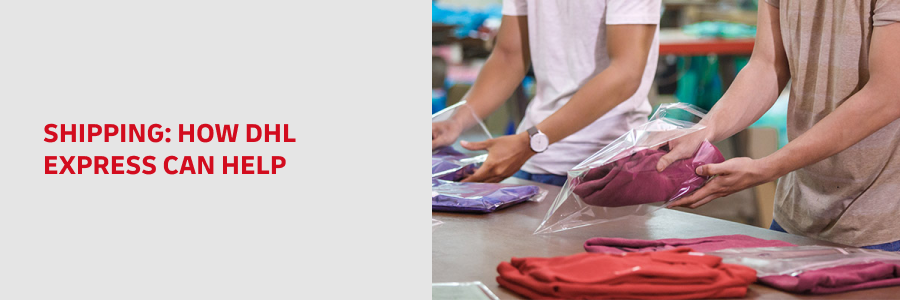 DHL Express has all the tools to help your business ship to e-commerce customers seamlessly, wherever in the world they may be. For example DHL's Packing Guide for Fashion Apparel will talk you through the optimal packaging for different garments to ensure that your orders are delivered quickly and easily to your customers.
DHL Express has all the tools to help your business ship to e-commerce customers seamlessly, wherever in the world they may be. For example DHL's Packing Guide for Fashion Apparel will talk you through the optimal packaging for different garments to ensure that your orders are delivered quickly and easily to your customers.
Fashion moves fast – you need a logistics partner who can keep up! With a DHL Express Business Account, you’ll have support from the experts as you navigate all aspects of international shipping.
1 – Statista, 2023
2 – Saffron Edge, November 2023
3 – Zurich, January 2023
4 – Statista, September 2023
5 – McKinsey & Company, 2023
6 – McKinsey & Company, 2023
7 – McKinsey & Company, 2023
8 – Medium, June 2026


